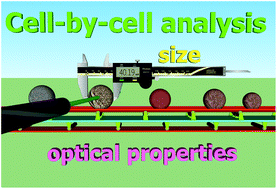Spectrophotometric analysis at the single-cell level: elucidating dispersity within melanic immortalized cell populations†
Abstract
It is widely held that the melanosome is an exemplar of the absorption features of melanin-containing cells, which are assumed to be uniform in both size and optical characteristics. In recent years, however, it has become increasingly apparent that this is a strikingly poor assumption. Indeed, melanin extracted from natural sources and synthetic melanin both show wide variability in their degree of polymerization (molecular weight) and spectroscopic characteristics. In the current study, imaging spectrophotometry performed on individual cells of immortalized melanin-producing cell lines revealed broad distributions in their sizes: 9.5–36.2 μm for Hs936 human melanoma cells, 10.9–20.8 μm for T47D human breast cancer cells, 5.3–43.5 μm for B16F1 mouse melanoma cells, and 6.4–54.2 μm for B16F10 mouse melanoma cells. The color appearance (from translucent to yellow to nearly black), absorption spectrum, and absorption (extinction) coefficient at 532 nm (28.73 to 364.75, 0.01 to 40.17, 5.88 to 977.19, and 0.01 to 1120 cm−1 for Hs936, T47D, B16F1, and B16F10 cells, respectively) of an individual cell also vary widely and cannot be adequately described by a ‘typical’ value. In comparison, human red blood cells are much more uniform in size (6.0–8.1 μm diameter; 1.9–3.2 μm thickness), although they too show a broad range of absorptivities, with extinction coefficients in the range of 65 to 370 cm−1 when measured at 532 nm. To further evaluate the impact of these findings on photoacoustic bioanalysis, we performed simulations of the generation of photoacoustic signals expected from these cell types. These simulations revealed that their variation in optical features exerts a pronounced effect on the amplitude and shape of the photoacoustic signals generated from these cell types. Finally, we compared the photoacoustic signal generated from these cells under ideal conditions (i.e., a single cell in isolation) versus a heterogeneous real-world sample, demonstrating that when a single or few cancer cells are present within a blood droplet, the photoacoustic signal is indistinguishable from that measured from blood alone. These outcomes have important ramifications for the early photoacoustic detection of cancer cells and circulating tumor emboli, while pointing to the potential of single-cell imaging spectrophotometry to assess heterogeneity within cell populations in more quantitative terms.



 Please wait while we load your content...
Please wait while we load your content...